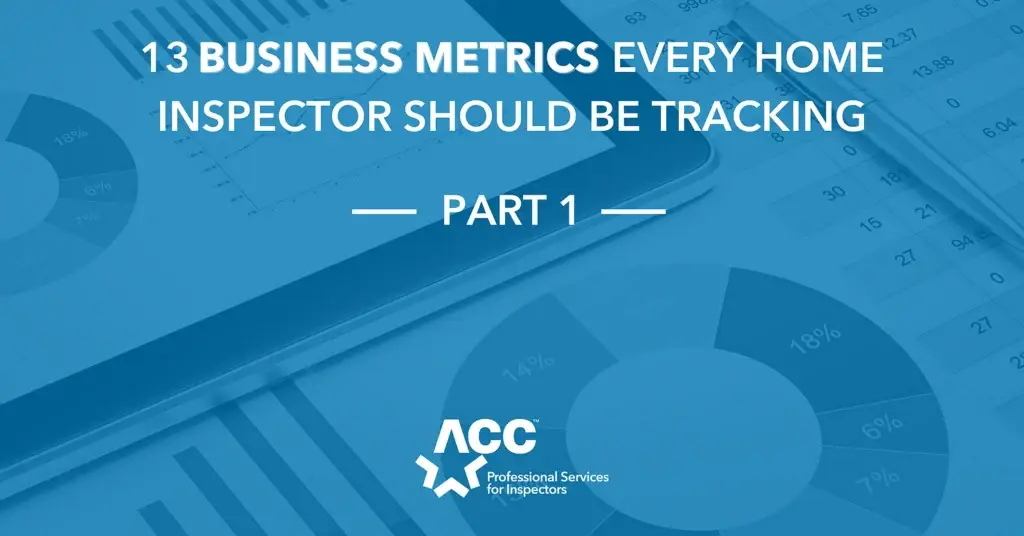[PART 1 OF 2]
First off…what are business metrics?
Depending on your experiences in the business world, business metrics can mean different things to different people in different situations. In the case of your home inspection business, it is a quantifiable measure of components of your business. They are used to track and assess the various aspects of your business – providing you a good sense of how your business is performing and if you are meeting your business goals.
Why the heck are they so important?
There are three key reasons why metrics are important to your business.
A. It will improve…
Your decision making with business decisions. Often business owners rely on their instincts when making decisions, which can be led by emotion and not objective reasoning. By looking at the data, you can avoid, or at least minimize, the emotional bias with key decisions. By relying on the facts and the data behind them, rather than an opinion, you will make better decisions that will increase the success of your business.
One example is with your pricing. Do you have data that says you cannot increase your prices 10% or more, or are you relying on your gut? By tracking a few items in your business, you can make a change, see how it impacts your business, then adjust accordingly, rather than guessing change is bad, artificially limiting your ability to grow your revenue.
B. You can track…
Your progress towards your goals. Many business owners are tracking their inspection volume, which gives them a map that both tells them where they are and the path of their home inspection journey with the number of inspections. But if you are looking to grow, by setting goals and tracking your progress in other areas (Sales and Marketing, for example) you will be able to see progress you are making and see if you may need to take other actions if improvements are needed.
C. It allows…
You to catch problems. Looking at the data over time will allow you to identify trends and spot a problem before it damages your company. For example, you notice while inspection counts are stable the number of agents using you has declined. What would happen if one or two of those top agents went away? By finding these trends early you can dig in and try to find and resolve the underlying issue before it impacts your company’s bottom line.
What should you be tracking?
The recommendations below are the base recommended metrics for a home inspection company. They are not exclusive and if you have others that you track, fantastic! The focus is on key metrics that can directly impact different aspects of your business and ultimately your profitability.
Business/Financial Metrics
1. Total Revenue
This metric tracks the amount of money your company is bringing in. Simply put, without revenue you do not have a business and fortunately this tends to be one of the easiest to track. You will want to look at this from a month-over-month perspective (MOM – which accounts for the seasonality of the inspection industry), year-over-year (YOY – to see how your business is growing) and year-to-date (YTD – to help you with your goals).
2. Overhead – Fixed Costs
A home inspection company is generally a low overhead business when starting out and often increases as you grow. Fixed costs are those expenses that you pay to run your business, even if you are not doing any inspections (those expenses – variable – are covered below). Rent, employees (typically non-inspectors), vehicle payments and insurance are considered fixed expenses. If you do an owner draw this would be a fixed cost as well. You will want to look at this on a monthly and annual basis as a percent of your revenue.
3. Variable Costs
These are expenses that relate to delivering your services (the home inspection and ancillaries). An example would be inspector commissions on services performed. Other expenses that are only incurred because a service was performed would include lab fees, sample costs, etc. You will also want to look at this on a monthly and annual basis as a percent of your revenue.
4. Profit / Gross Margin
Subtract your fixed and variable costs from your revenue and you have your profit. At the most basic level you want your revenue to be higher than your expenses, else it is hard to run your business (unless you are just starting out, then you should have goals in place to get to break even by a certain date).
In addition to tracking your overall profit you should track your gross margin. This will tell you how much profit you are making from each sale. There are several options for calculating it, but for your business keeping it simple is better.
The simple formula is: Gross Margin % = ((Total Revenue – Total Costs) / total Revenue) x 100
For example, if your annual revenue was $100,000 and your total costs were $30,000, your gross margin is 70%.
Gross margin goes together with profitability, and typically as your business expands (bring on new inspectors, expanding your partnerships) you may see your margins decrease a touch while profitability increases. That is okay! When planning you should use both to decide where you may want to invest to grow your business and you should look at this at a monthly, annual, MOM, YOY and YTD basis.
5. Inspection / Services Volume
In addition to tracking the number of home inspections by type, it is important to track all the other services you provide as well. This will help identify trends and areas of future focus. Are you seeing a change in the number of Radon tests associated with a home inspection? Do you see an opportunity to grow your new sewer scope service? How many of your inspections include ancillary services? As the industry is typically cyclical, seeing the trends can help you adjust your marketing efforts to build awareness of other services during the slower times to help maintain your revenue stream.
This will also provide data if you may need to adjust how you are selling your services. Bundling services into different packages may increase ancillary sales if there is perceived value. Based on the trend data there may be indicators that it is time to revisit your pricing. Having a good pulse on all of your services may also help you identify future growth areas.
6. Agent Lifetime Value
Many businesses track customer Lifetime Value (LTV), but due to the nature of the real estate industry the customer is typically a real estate agent, with the client being the home buyer or seller. For a variety of reasons, data shows that the average length of home ownership has increased to over eight years (ipropertymanagement.com). So, unless your client is an investor, the typical lifetime value of a client is the price of a home inspection. Real estate agents, on the other hand, are now averaging 10 residential transactions per year (NAR). The reality is that some agents are doing a lot more than 10 per year, while others are doing significantly less (in some regions there are many part-time agents where the average might be one transaction per year or less!).
Knowing your agents, how many transactions they do a year and how many inspections they book with your company will give you guidance on projecting future revenue and helping hone your marketing strategy. To formula to calculate Agent LTV is:
Agent Lifetime Value (LTV) = Average inspection cost x Number of inspections ordered per year x Average Agent lifespan (recommending capping at 5 years) x Gross Margin
For example, if you have an agent regularly bringing you five inspections a year, averaging $500 per inspection, assuming a 5 year “lifetime” and gross margins of 75%, the LTV of that agent is $500 per inspection x 5 inspections per year x 5 years * .75 or $9,375.
Why is this useful?
-
It can help you decide how much to spend on attempting to acquire new agents.
-
It can help you decide where to invest with your existing agents.
-
You will be able to see which agents provide the most value to your business.
-
You will be able to see which agents have potential to provide more value to your business.
-
If you have an agent who has only ordered one inspection from you, but they are a top producer, building that relationship to attract more business will increase the value of that agent and generate more revenue for your business.
-
-
You will be able to see where you should shift your investments to get the greatest return per agent.
In part two of this post, we’ll explore seven other business metrics every home inspector should be tracking, including critical metrics associated with sales and marketing.


